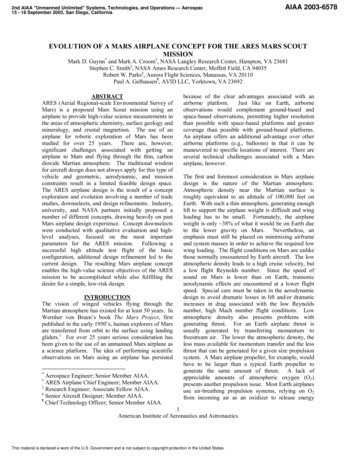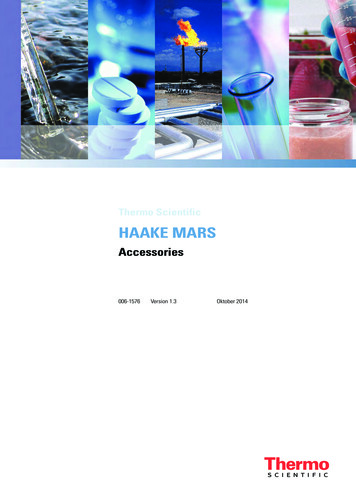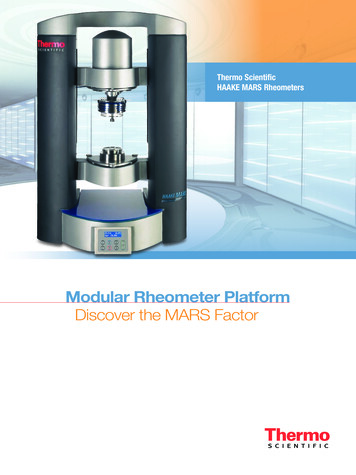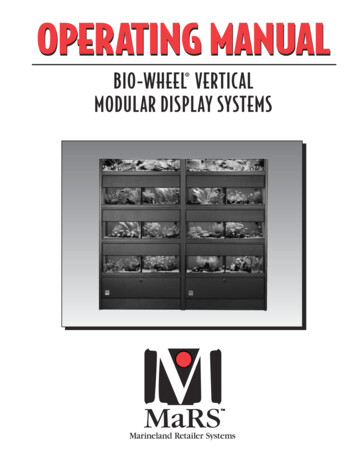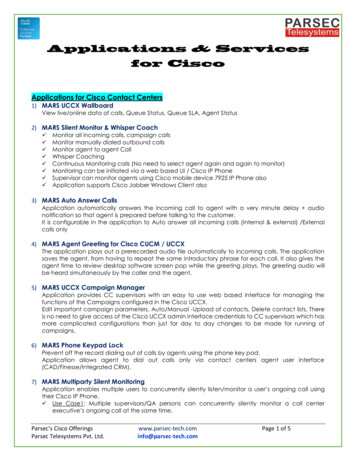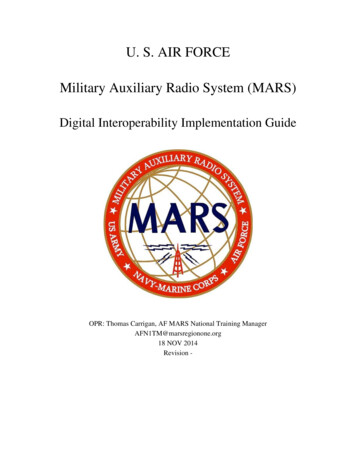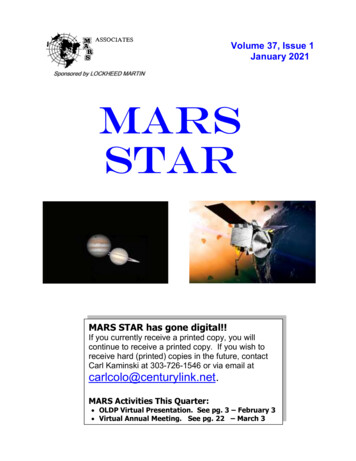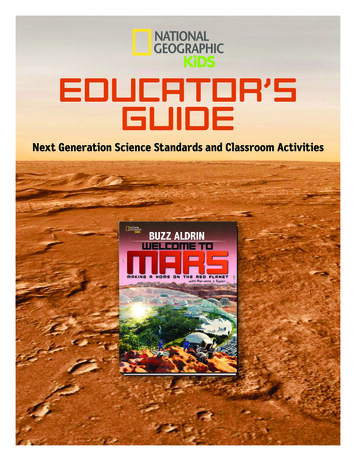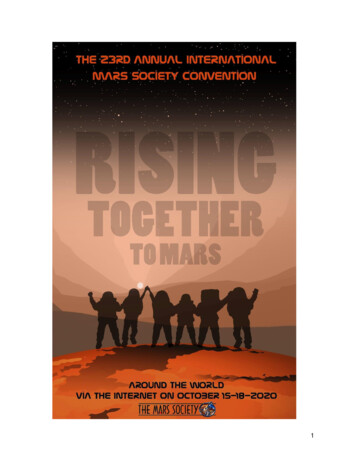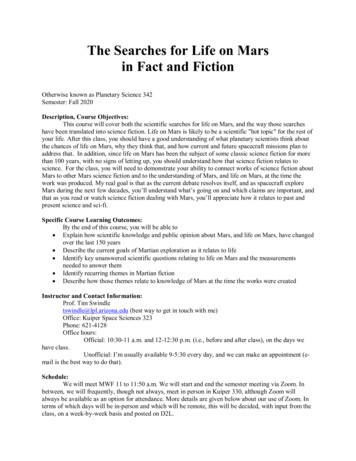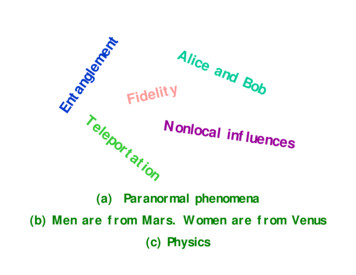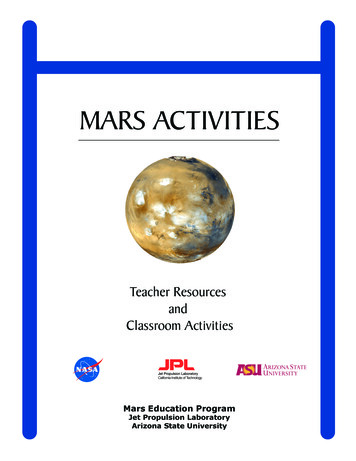
Transcription
MARS ACTIVITIESTeacher ResourcesandClassroom ActivitiesMars Education ProgramJet Propulsion LaboratoryArizona State University
Mars MissionsInformation and UpdatesMission InformationAvailable atJet Propulsion LaboratoryMars Exploration Home Pagehttp://mars.jpl.nasa.govMore Educational ActivitiesAvailable atJet Propulsion LaboratoryMars Education & Public Outreach Programhttp://mars.jpl.nasa.gov/classroomorArizona State UniversityMars K-12 Education Programhttp://tes.asu.edu/neweducation.html
Table of Contents1. Earth, Moon, Mars Balloons2. Rover Races3. Areology - The Study of Mars4. Strange New Planet5. Lava Layering6. Searching for Life on Mars7. Mars Critters8. Exploring Crustal Material from a Mystery Planet- Graph Paper9. Edible Mars Rover- Mars Pathfinder Rover10. Edible Mars Spacecraft- Mars Global Surveyor- Mars Pathfinder- Mars Pathfinder Rover11. Mars Meteorites’ Fingerprints12. Introduction to Creating a Mission Plan13. Out of Sight: Remote Vehicle Activity- Mars Rover Websites15. Probing Below the Surface of Mars16. Good Vibrations17. The Mathematics of Mars- “I Have Who Has?” Cards18. Mars Bingo19. Mud Splat Craters20. Solar System Beads Distance Activity21. Alka-Seltzer Rockets22. Soda Straw Rockets23. Mars Pathfinder: Two-Dimensional Model24. Mars Pathfinder: Egg Drop and Landing25. Cool Internet 00112115118122126127128
Earth, Moon, Mars Balloons1Introduction:How big is the Moon; how far is it relative to Earth? Earth science and astronomy books depict amoon that is much closer and much larger than in reality. The example below is typical of what is foundin textbooks:The balloon activity will allow students theopportunity to construct a scale model of theEarth-Moon system, both in terms of planetarysizes and distances. In addition, students make ascale model of Mars, and discover how far onemight have to travel to visit the most Earth-likeplanet in our Solar System. It is also a goodicebreaker at the beginning of a semester, to getstudents to interact with each other.National Science Education Standards:Standard D: Earth in the Solar SystemMaterials (for a class of 27): 1 bag blue balloon (at least 9 per bag)1 bag white balloons1 bag red balloons27 copies of Planetary Data HandoutRulers/measuring devices in both inches and centimetersStep - By - Step Instructions:1. Obtain balloons. The best are balloons with 2 1/2 inch diameter when deflated, but any balloons willwork. An easy way to do this activity is to purchase balloons that are colored. The red, white,and blue balloons can be used for Mars, Moon, and Earth. (using green for Earth and yellow forthe Moon are also fine).2. Discuss the question of size of the Earth relative to the Moon. Determine what misconceptions thestudents may have.3. Distribute balloons. It is best to provide one third of the class with "Earth" (i.e. blue), one third with"Moon" (i.e. white), and one third with "Mars" (i.e. red).4. Distribute Planetary Data Handout, one per student.5. Tell students that the Earth balloon will have a diameter of 20 cm. Have them figure out the scale(divide the Earth's actual diameter by 20 cm. Earth is about 63,800,000 times larger than 20 cm).Ask students with Earth balloons to inflate their model approximately 20 cm (obviously theballoon is not a perfect sphere, but neither is the Earth).
26. Ask students to look at the handout and calculate the size that the Moon and Mars should be, at thesame scale as the Earth model. (Note the teacher's copy has the answers: the Moon should beabout 5 cm, Mars about 11 cm).7. Have students inflate the Mars and Moon balloons.8. Ask students, at this scale, how far apart are the Earth and Moon? The diagrams seen in commontextbooks might lead many of them to suggest that the Moon balloon should be held less than ameter from the Earth balloon.9. Have students calculate the distance from Earth to the Moon at the same scale as the balloon models.The distance is about 6 meters. Have students holding the Earth models stand at one side of theroom, and a partner holding a Moon model about 6 meters away.10. Point out to students that they now have a scale model of the Earth-Moon system. Earth and itsMoon are considered a double planet. The distance between the two is the distance traversed bythe Apollo astronauts who went to the Moon in the 1960's and 70's. (Have students recall thefilm Apollo 13).11. Compare the size of the Mars model with the Earth and Moon model. Look at the distance betweenEarth and the Moon.12. Ask students how far away they think Mars will be at this scale. Have students attempt todemonstrate it in the classroom.13. Have students calculate the distance to Mars at this scale. The answer is about 12,000 cm, which inmore familiar terms is 3/4 of a mile! Have students identify a local landmark that is about 3/4 ofa mile away.14. Discuss the relative distance between Earth and Mars in the context of a human trip. How long did ittake for Apollo astronauts to get to the Moon? (3 days) How long would it take for astronautsusing similar technology to get to Mars? Mars Pathfinder, which launched in December 1996,arrived at Mars on July 4,1997 (7 months). Mars Global Surveyor, which launched in November1996, arrived at Mars in September 1997 (11 months).Extensions:1. Ask students to make models of the Martian moons, Phobos and Deimos, at the same scale as theballoon models. They can calculate their scale diameters from the enclosed chart. It turns out thatthey are about the same size of a small grain of sand!2. Have students convert all metric measurements into the English system.1 inch 2.54 cm, 1 mile 1.6 kmAnswers to balloon exercise:Scale DistancesEarthEarthMoonMars(km) / 638 (cm)3.84 x1057.80 x107600 cm 20 ft1.2 x 105 cm 3/4 mi
Planetary ePluto5.2039.53719.19130.06939.4 81Distance from the Sun (AU)0.3870.7231Approximate Distance fromthe Sun (10 24,7641,195Mass (Earth 1)0.0540.8810.1491,13675552440.005Density on Pe riod (day length)58.65-2 43.020.991.030.410.44-0.7 20.67-6.39Orbital Period (year in .6211.8811.8629.4283 .75163.72248.02Orbital Tilt (degree s)0177.323.4525 Sideral Period (length ofyear in Earth yea rs)1.524GlossaryAU - astronomical unit, the distance betwee n Earth and Sun( 1.495 * 10 8).Rotation Pe riod - the length of the day.Orbital Period - the length of the year in Ea rth days.Retrograde - when a ce lestial body rotates in the oppositedirection of the Earth or clockwise.4,498,2505,906,370Balloon ExerciseBodyDiameter (km) / 638EarthMoonMarsPhobos Approximate Scale (cm)12,7563,4766, 79422Satellite - another name for a moon.Scale DistancesSideral Period - the length of a planet’s yea r in Earth years.EarthEarthTilt - how a far a plane t is tilted sideways on its axis, measuredin degree s.2,870,980MoonMars 20 cm 5 cm 11 cm 0.03 cm(km)3.84 x 10 57.80 x. 10 7/ 638 (cm)600 cm 20 ft1.2 x 105 cm 3/4 mi
4Rover RacesGoal:The students will learn the challenges of operating a planetary rover and problem solvesolutions by using a hands-on simulation.Objective: To have the rover driver design and execute a series of commands that will guide a humanrover through a simulated Martian surface, allowing the rover team to experience some ofthe challenges of teleoperating a robotic vehicle on another planet.Time Frame: 45 minutesNational Science Education Standards:Standard G: Nature of scienceNational Math Education Standards:NM.5-8.2 CommunicationNM.5-8.13 MeasurementNational Technology Education Standards:NT.K-12.3 Technology Productivity ToolsNT.K-12.4 Technology Communication ToolsItems Needed: Large playing area (classroom, gym, or outside area) Three blindfolds per team A clipboard and pencil for each driver and official Obstacles - laminated construction paper works well (note: do not use any materials thatthe blindfolded students will trip or fall over). A stopwatch for the timer of each team Driver's sheet Job cards with team numbersBackground Information:Many students think that robotic vehicles (like the Mars Pathfinder Sojourner Truth rover) can bedriven much like they drive their toy radio-controlled cars. They imagine a rover driver watching acomputer screen showing the rover on Mars and moving a joystick to make it go. The reality is not so!The time it takes for a command to reach the surface of another planet (such as Mars) varies with thedistance between the planets involved. This prevents any "joy-stick" driving in real time. The commandstravel via radio waves at the speed of light (186,000 miles / second) and can take many minutes to reachtheir destination. Much can happen to an interplanetary robotic vehicle during this time interval. If, forinstance, a command were given from the Earth-base for it to go forward on Mars and the Earth-base gota reply (say 12 minutes later) saying that the rover was indeed traveling forward. It would then take
5another 12 minutes to send a command from the earth-base to stop the rover. If the rover runs intotrouble, crashes, or flips over, there is no one there to fix the situation. The rover mission is over!In real remote sensing operations using robotic vehicles, NASA uses "smart rovers." Rovers areprogrammed with artificial intelligence that helps to keep it out of trouble. During the Mars Pathfindermission, the mission science team would decide, as a group, which areas of the landing site or whichparticular rocks located in the landing site they wished to investigate. This information was relayed tothe rover driver. The driver, viewing the landing site on a computer screen and using Virtual Realitygoggles, then designed and uploaded the commands to the rover on which target it needed to find. Therover would then "think" its way over to that target very slowly (another big difference between thetoy cars that often speed around and crash!)The Sojourner Truth rover (JPL website: http://marsweb.jpl.nasa.gov) was equipped with acamera and lasers that sent a series of beams out in front of the rover. If the beams came back unbent, itmeant that the way was clear of obstacles. The rover would then move 1/2 a wheel turn and stop. Itrepeated this cycle, slowly moving toward the designated target. If the beams come back bent, the roverdecided how bent (how big of a rock or crater is in front of it) and chose to either go over the obstacle, ifit was small enough, or avoid it all together by going around it. Eventually, the rover arrived at thepredetermined target, ready to collect the science data. Once the rover reached the target, it used itscamera to take a closer look or deploy a special instrument called the APXS (Alpha-Proton X-raySpectrometer) to analyze the rock. The Sojourner rover was not designed to travel very far away fromthe lander (approximately 15 meters). The lander camera kept the rover in view at all times.The Athena rover payload (Athena website at http://athena.cornell.edu), was designed for theMars Explorer Rover Mission due to launch in 2003. These rovers are even smarter and bigger rovers!This "super-rover" will be much like a roving geologist on Mars. This rover will have a lot moreinstruments available onboard to test rock samples, soil samples, and conduct science experiments. Thisrover will travel much farther away from the lander (up to 1 kilometer) and have its own navigationcapabilities. The Mars Explorer Rover will have a series of cameras (navcam, pancam, hazcam, and abellycam) and will be able to send back different camera views for the scientists on Earth to see. As eachrover travels across the surface of Mars, the scientists will periodically stop, have the panoramic cameratake a picture, then pick an area in the camera's view to. Send the rover. Rocks will be selected forimaging up close by the camera and the microscopic imager. Since a reddish dust covers much of therocks and surface of Mars, a special instrument called the Mini-Thermal Emission Spectrometer (miniTES) will use an thermal infrared (TIR) detector to look through the dust and view what type of rock ormineral might be near the rover. Other types of instruments on the rover will be able to take otherimportant scientific readings about the rocks they encounter.Before any robotic vehicle (such as a rover) is sent into space to journey to another planet, it istested here on Earth first. Scientists are already testing the prototype of the Athena rover. This prototypeis called the FIDO (Field Integrated Design and Operations) rover and was tested the spring of 1999and 2001 (FIDO website at http://fido.jpl.nasa.gov and http://wufs.wustl.edu/lapis2 ) in the western U.S.deserts by scientists and high school students.
6Preparation:1.Prepare a set of job cards for each rover team. Use 3” x 5” index cards, making a drivercard, 3 rover cards, a timer card, and a judge card for each team.This makes it easier to assign the next group of students by handing out the cards toreserve their role.Use construction paper ties (red 12” x 12” work well) to create the obstacle course thatthe rovers will traverse. Laminated ties work the best and last for many uses. Do not usedesks or chairs, as students may trip over them. Make any type of course by arranging theties symmetrically. An easy example of this might be:2.3.000000000000STARTING LINEXXXXXXXXXXXXX XXXXXXXXX XXX XX XX XX XX XX XXX XXX XXX XX XX XXXX XXX X XXXX XFINISH LINE0 rover teamsProcedure:1.Preface the activity with a lesson on planetary rovers (e.g. Sojourner, FIDO, or Athena).Good resources can be found at the APEX/Athena website at http://athena.cornell.edu orthe Jet Propulsion Laboratory website at http://marsweb.jpl.nasa.g
Mars Pathfinder: Egg Drop and Landing 127 25. Cool Internet Sites 128. Earth, Moon, Mars Balloons Introduction: How big is the Moon; how far is it relative to Earth? Earth science and astronomy books depict a moon that is much closer and much larger than in
